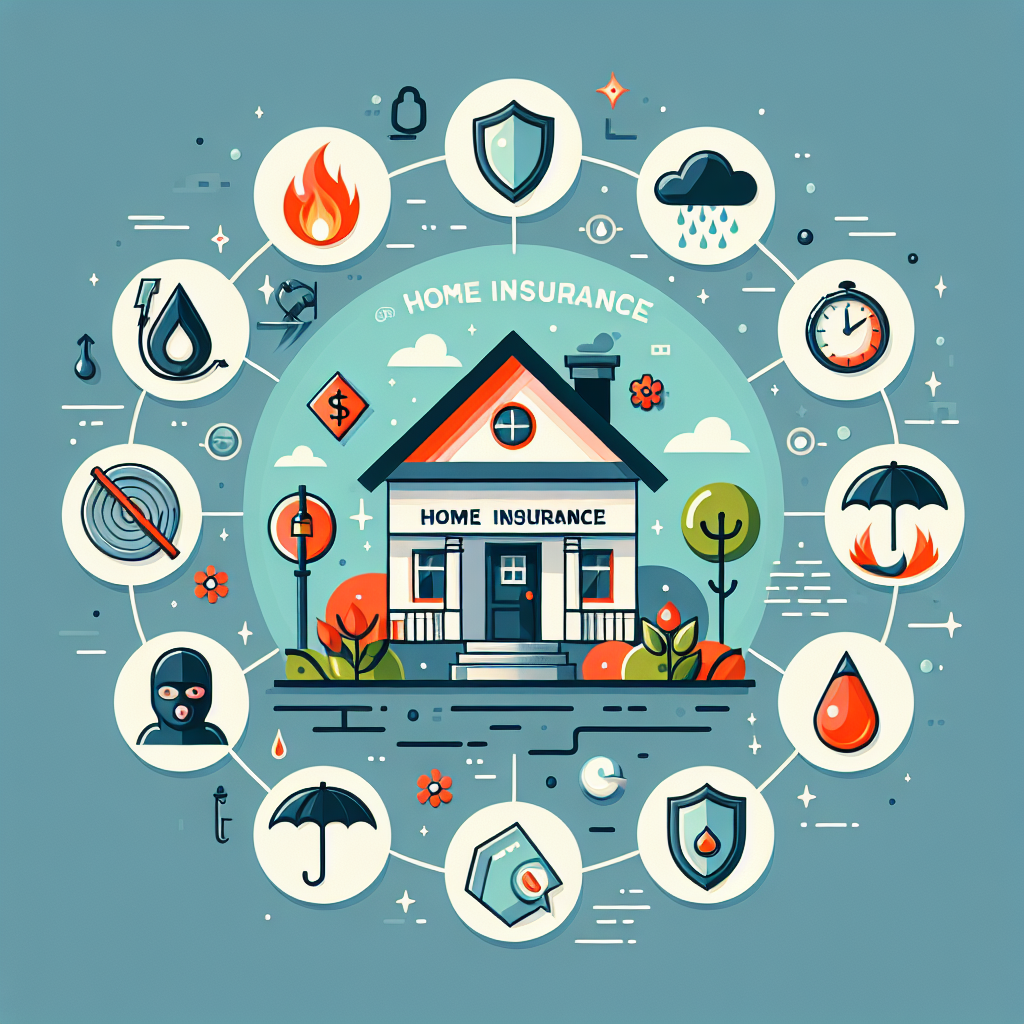Filed under Home Insurance on
Umbrella Coverage Home Insurance: What to Know

If you’ve ever looked around your home and thought, “One serious accident could upend my finances,” you’re already thinking like a risk manager. For many households, the missing piece of protection isn’t more property insurance—it’s a broader layer of liability protection that kicks in when a lawsuit or judgment exceeds standard policy limits. If you’re searching for Umbrella Coverage Home Insurance guidance, this article breaks down how umbrella policies work, who benefits most, what they cost, and how to choose the right limits with confidence.
What an Umbrella Policy Actually Does
An umbrella policy is extra liability insurance that sits on top of your home, auto, and sometimes watercraft or landlord policies. When a covered claim exhausts the liability limits on those underlying policies, the umbrella takes over up to its limit—often $1 million to $10 million. In plain terms: it’s financial shock absorption for worst-case scenarios.
Unlike standard liability coverage on your homeowners insurance (which protects you when you’re legally responsible for injuries or damage to others), umbrellas often also include protection for personal injury offenses like libel or slander. That matters in a world where an online post can trigger a costly defamation suit. If you’re evaluating Umbrella Coverage Home Insurance, think of it as a safeguard for your savings, future earnings, and peace of mind.
How Umbrella Works with Your Home and Auto Policies
Umbrella liability is not a standalone shield; it layers on top of existing coverage. If someone is injured at your home and you’re found liable, your homeowners liability limit pays first. If that’s not enough, your umbrella covers the excess amount, up to the umbrella limit. The same logic applies to auto liability after a serious crash.
Key mechanics to understand
- Underlying requirements: Insurers require certain minimum liability limits on your home and auto policies (for example, $300,000 personal liability on homeowners and 250/500/100 on auto). Without those minimums, the umbrella may not respond.
- Defense coverage: Many umbrellas cover legal defense costs, often in addition to the liability limit. That can be crucial in complex cases where attorney fees, expert witnesses, and court costs mount quickly. Check your policy wording.
- Worldwide coverage: Personal umbrella coverage typically follows you worldwide for personal liability (with exceptions and sanctions limitations). Good to know if you travel.
- Self-insured retention (SIR): For certain covered claims not sitting over an underlying policy (e.g., a personal injury offense if your home policy doesn’t include it), you may pay a set amount (like $250–$1,000) before the umbrella responds.
What Umbrella Insurance Covers—and What It Doesn’t
Common covered losses
- Bodily injury to others (e.g., a guest’s serious injury from a fall or pool accident at your home).
- Property damage to others (e.g., your tree damages a neighbor’s home and the costs exceed homeowners liability limits).
- Personal injury offenses (e.g., libel, slander, false arrest)—often broader than home policy endorsements.
- Incidents involving household members and pets (e.g., dog bites). The Insurance Information Institute reports dog bite and related injury claims cost insurers over a billion dollars annually in the U.S., with the average claim payout continuing to rise.
- Landlord liability if the rental property is scheduled and covered appropriately.
Common exclusions
- Business activities—unless endorsed or you purchase a commercial umbrella.
- Intentional or criminal acts.
- Professional liability (e.g., malpractice; requires dedicated coverage).
- Contractual liability beyond what’s covered by underlying policies.
- Certain watercraft or recreational vehicles if not properly insured in the underlying layer.
When comparing Umbrella Coverage Home Insurance options, ask your agent to walk through gray areas such as short-term rental liability, volunteer or board service, and coverage for household employees. Wordings vary by carrier.
Who Needs Umbrella Coverage?
Wealthy households aren’t the only ones at risk. Liability lawsuits target both current assets and, in many states, future wages. With medical costs and jury awards trending higher, even middle-income families face exposure that can surpass standard policy limits.
Profiles that often benefit
- Homeowners with a pool, trampoline, or frequent guests.
- Households with teen drivers or high-mileage commuters. Crash severity for young drivers is well-documented by public health agencies, elevating risk.
- Pet owners, especially with larger breeds.
- Landlords, including those using long-term leases or occasional short-term rentals.
- Active social media users or individuals in public-facing roles (defamation risk).
- Volunteers or board members for nonprofits (some umbrellas extend personal liability beyond the board’s D&O policy).
- High earners and professionals whose future wages could be garnished after a judgment.
Industry trendlines matter here. Carriers and reinsurers have cited “social inflation” and the rise of “nuclear verdicts” (jury awards exceeding $10 million) over the last several years. Even if your personal risk feels modest, settlement expectations have moved upward, and legal defense costs alone can be daunting. That’s why many households, not just those with substantial wealth, are exploring Umbrella Coverage Home Insurance as a prudent risk hedge.
How Much Umbrella Coverage Should You Buy?
Limits typically start at $1 million and can go to $5 million or $10 million with personal carriers. High-net-worth specialists may offer even higher layers.
Rule-of-thumb approach
- Estimate exposed assets: home equity, savings, investment accounts, rental property equity.
- Add your risk profile: youthful drivers, pool, dog, rental properties, high net worth, public visibility.
- Consider future earnings: Multiply annual income by 3–5 years as a proxy for potential wage garnishment exposure, depending on your state’s laws and protections.
- Map local legal climate: Some venues have a track record of higher verdicts; your agent may have insight.
- Choose a limit that comfortably exceeds assets plus potential income exposure, balancing premium affordability.
For many families, $1–3 million is common; higher-income households or those with multiple risk factors (teen drivers and a pool, for example) often opt for $5 million or more. Don’t overlook inflation: medical costs, lost wages, and legal fees have been trending up, making higher limits more compelling than they were a decade ago.
What Does It Cost?
Umbrella premiums are generally affordable compared to the amounts of protection they provide. A common range is $150 to $400 per year for the first $1 million, with each additional million costing less than the first. Pricing varies by state, carrier appetite, and your household risk profile.
Factors that influence your rate
- Underlying liability limits (meeting higher minimums can sometimes reduce the umbrella premium).
- Driver mix and records in the household (teen drivers, DUIs, at-fault accidents raise cost).
- Home features (pools, trampolines, aggressive-breed dog exclusions or surcharges).
- Prior claims history.
- Number and type of properties, watercraft, or recreational vehicles.
- Requested umbrella limit.
Ways to save without sacrificing protection
- Maintain clean driving records and complete defensive driving courses where applicable.
- Bundle home, auto, and umbrella with one carrier to qualify for multi-policy discounts and smoother claims coordination.
- Raise underlying home and auto liability limits—this can sometimes reduce the umbrella cost and improves protection even before the umbrella kicks in.
- Proactively manage risks: pool fencing and alarms, dog training and control, property maintenance, and documented safety measures.
For many buyers, the value proposition is straightforward: a few hundred dollars a year to help protect hundreds of thousands or millions in assets and income. That’s why Umbrella Coverage Home Insurance has become a common recommendation among financial planners and risk advisors.
Qualifying for an Umbrella: Requirements and Underwriting
Insurers set minimum underlying limits to ensure the umbrella only engages for catastrophic losses. While specifics vary, many carriers require at least $300,000 in homeowners personal liability and auto liability of 250/500/100 (or a $300,000 combined single limit). Watercraft and recreational vehicles may also need specific underlying limits.
Most Umbrella Coverage Home Insurance policies require that all household drivers be listed and meet underwriting standards. Expect additional scrutiny if your home has a diving board, your property hosts large gatherings, or you have frequent short-term rentals. Some carriers exclude certain dog breeds or require proof of fencing and other risk controls for pools. Your agent can help you find a market that fits your profile.
Real-World Claim Scenarios
1) A serious guest injury at your home
A friend trips on an uneven step and suffers a traumatic knee injury and complications. After surgery and months of lost wages, the claim approaches $800,000. Your home policy pays its $300,000 limit; your $1 million umbrella covers the remaining $500,000 plus defense costs according to policy terms.
2) A teen driver causes a major crash
Your 17-year-old rear-ends a minivan, injuring multiple occupants. Settlements and medical bills exceed your auto limits by $1.2 million. The umbrella fills the gap and funds a legal defense.
3) A defamation suit tied to social media
You post a negative review that a business claims contains false statements causing reputational harm. Your umbrella covers personal injury offenses beyond your home policy scope, subject to its definitions and exclusions, and provides legal defense, which can easily reach six figures.
Umbrella vs. Excess Liability vs. Endorsements
It’s easy to confuse terminology. Here’s a simplified guide to keep it straight:
- Umbrella liability: Typically broader coverage that can drop down to cover certain personal injury offenses not covered by underlying policies (subject to a self-insured retention).
- Excess liability: Usually follows the underlying policy’s terms without broadening coverage; it simply adds more limit.
- Homeowners liability endorsement: Increases the liability limit on your home policy but doesn’t provide cross-policy protection or broader offenses like an umbrella often does.
- Personal umbrella policy (PUP): Another shorthand for umbrella; often packaged with the same carrier as your home and auto.
Confirm whether your policy is “true umbrella” or pure excess. This can affect coverage in cases like defamation, false arrest, or other personal injury offenses.
Short-Term Rentals, Landlords, and Business Activities
If you rent your home short-term or own investment properties, talk to your agent about proper underlying coverage and scheduling those properties on the umbrella. Some umbrellas exclude or limit short-term rental liability unless specific endorsements are in place. For long-term rentals, a dwelling policy with adequate liability limits is typically required as the underlying layer.
Running a business from home? Your umbrella will not replace business liability coverage. If clients visit your home office or you provide services, consider a home-based business policy, professional liability, or a commercial umbrella to complement your personal protections.
Myths and Mistakes to Avoid
- “I don’t have assets, so I don’t need an umbrella.” Even without substantial assets, future income may be at risk after a judgment in many jurisdictions.
- “Umbrella covers my property.” Umbrella is for liability to others; it doesn’t pay to repair your own home or car.
- “Any limit is fine.” Choose limits based on assets, risk factors, and the legal environment where you live and drive.
- “I can keep my auto limits low if I buy an umbrella.” Carriers usually require high underlying auto limits; skipping them can render the umbrella unresponsive.
- “All umbrellas are the same.” Coverage for personal injury offenses, defense costs outside limits, and excluded activities vary by carrier.
How to Shop and Compare Policies
Smart shopping checklist
- Confirm required underlying limits for home, auto, watercraft, and rentals.
- Ask whether defense costs are in addition to or inside the umbrella limit.
- Review coverage for personal injury offenses (libel/slander) and any requirements for drop-down coverage.
- Clarify exclusions for business activities, short-term rentals, specific dog breeds, recreational vehicles, or watercraft size/horsepower.
- Inquire about uninsured/underinsured motorist coverage at the umbrella level—some carriers and states offer this, which can protect your family if an at-fault driver has low limits.
- Evaluate multi-policy discounts by bundling home, auto, and umbrella.
- Check financial strength ratings and claims service reputation.
When shopping for Umbrella Coverage Home Insurance, consider working with an independent agent who can compare multiple carriers. A specialist can also help structure higher limits using multiple layers if a single carrier won’t offer the total amount you want.
Legal Nuances and State Considerations
Liability law and protections vary. Some states shield certain assets (like retirement accounts or a portion of home equity) from creditors; others allow wage garnishment up to specified limits. Defamation laws and anti-SLAPP statutes differ widely and can influence defense strategies and settlement values. Consult a local insurance professional and, if needed, an attorney for personalized guidance on asset protection.
Why Umbrella Demand Is Rising
Several forces are pushing more households to consider umbrellas:
- Medical inflation and higher lost-wage awards.
- Rising severity in auto liability claims, particularly with distraction and larger vehicles on the road.
- Greater public exposure online, increasing personal injury claim potential.
- Reinsurance pressures that influence pricing and underwriting standards.
Insurers and risk analysts have highlighted increased frequency of large verdicts and settlements over the past decade. Against that backdrop, Umbrella Coverage Home Insurance offers an outsized protective bang for the buck.
Frequently Asked Questions
Is an umbrella required by law?
No, it’s elective. But lenders or asset managers sometimes encourage it for asset protection.
Do I need it if I rent and don’t own a home?
Yes—if you have a renters policy and auto insurance, an umbrella can still sit over those policies to protect your income and savings.
Will it cover family members?
Typically yes, for resident relatives listed on your policies. But verify driver and household member disclosures with your carrier.
Does it cover a side hustle?
Not usually. Business activities generally require separate commercial coverage or a home business endorsement.
How fast does it pay in a claim?
Umbrella carriers coordinate with underlying insurers. Complex claims can take time, but having all policies with one carrier often speeds communication and resolution.
A Step-by-Step Action Plan
- List your assets and estimate your future earnings exposure.
- Audit your risks: drivers, pool, pets, rentals, public activity, volunteer work.
- Increase underlying home and auto liability limits to at least your carrier’s minimums.
- Select an umbrella limit that exceeds your combined exposure; many families choose $1–5 million.
- Bundle policies for cost efficiency and seamless claims handling.
- Review annually and after life changes (new teen driver, home improvements, rental property acquisition).
Bottom Line: Protect the Life You’ve Built
Big financial hits rarely come from everyday mishaps—they stem from the rare but severe events no one sees coming. That’s exactly the territory an umbrella policy is designed to cover. By coordinating your home and auto liability with a well-structured umbrella, you create a resilient defense against life’s costly surprises.
If you’ve been weighing Umbrella Coverage Home Insurance, start by aligning your underlying limits, clarifying your exposures, and determining a comfortable limit. Speak with a seasoned agent, compare policy wordings carefully, and look beyond price to defense provisions and exclusions. With thoughtful setup, Umbrella Coverage Home Insurance can be one of the highest-value protections in your financial toolkit.
In short: a few hundred dollars a year can buy you millions in added protection, broader personal injury coverage, and the legal defense resources you want on your side when it matters most. That’s a smart trade for anyone serious about safeguarding their assets, their income, and their future.





